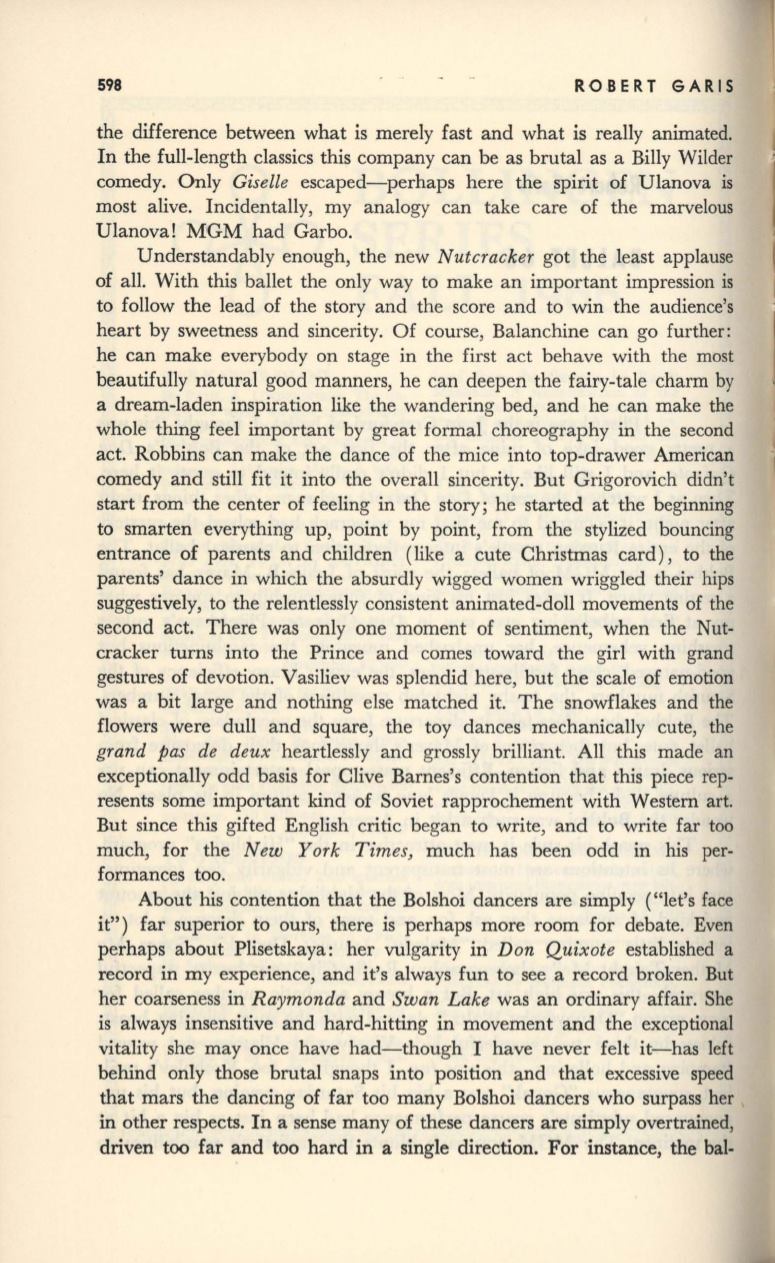
598
RO ,BERT GARIS
the difference between what is merely fast and what is really animated.
In the full-length classics this company can be as brutal as a Billy Wilder
comedy. Only
Giselle
escaped-perhaps here the spirit of Ulanova is
most alive. Incidentally, my analogy can take care of the marvelous
Ulanova! MGM had Garbo.
Understandably enough, the new
Nutcracker
got the least applause
of all. With this ballet the only way to make an important impression is
to follow the lead of the story and the score and to win the audience's
heart by sweetness and sincerity. Of course, Balanchine can go further:
he can make everybody on stage in the first act behave with the most
beautifully natural good manners, he can deepen the fairy-tale charm by
a dream-laden inspiration like the wandering bed, and he can make the
whole thing feel important by great formal choreography in the second
act. Robbins can make the dance of the mice into top-drawer American
comedy and still fit it into the overall sincerity. But Grigorovich didn't
start from the center of feeling in the story; he started at the beginning
to smarten everything up, point by point, from the stylized bouncing
entrance of parents and children (like a cute Christmas card), to the
parents' dance in which the absurdly wigged women wriggled their hips
suggestively, to the relentlessly consistent animated-doll movements of the
second act. There was only one moment of sentiment, when the Nut–
cracker turns into the Prince and comes toward the girl with grand
gestures of devotion. Vasiliev was splendid here, but the scale of emotion
was a bit large and nothing else matched it. The snowflakes and the
flowers were dull and square, the toy dances mechanically cute, the
grand
pas
de deux
heartlessly and grossly brilliant. All this made an
exceptionally odd basis for Clive Barnes's contention that this piece rep–
resents some important kind of Soviet rapprochement with Western art.
But since this gifted English critic began to write, and to write far too
much, for the
New York Times,
much has been odd in his per–
formances too.
About his contention that the Bolshoi dancers are simply ("let's face
it") far superior to ours, there is perhaps more room for debate. Even
perhaps about Plisetskaya: her vulgarity in
Don Quixote
established a
record in my experience, and it's always fun to see a record broken. But
her coarseness in
Raymonda
and
Swan Lake
was an ordinary affair. She
is always insensitive and hard-hitting in movement and the exceptional
vitality she may once have had-though I have never felt it-has left
behind only those brutal snaps into position and that excessive speed
that mars the dancing of far too many Bolshoi dancers who surpass her
in other respects. In a sense many of these dancers are simply overtrained,
driven too far and too hard in a single direction. For instance, the bal-


